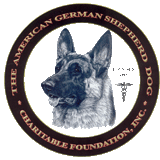Carolyn Z. Gerganoff – Health and Genetics Chair – GSDCA
A conversation with Dr. Robert A. Grahn, Ph.D, UC Davis about the status and predictability of current Degenerative Myelopathy (DM) testing.
I had the requirements for the GSDCA Health Award of Merit recently sent to the membership via Constant Contact. I received numerous emails about why Degenerative Myelopathy (DM) testing had to be submitted on a nominee, however the results were not disqualifying. Those who had lost dogs to DM were understandably upset by this. When I went to the University of Missouri website, the DM information was dated 2009. I reached out to University of Missouri to see if they had any updated information. To date, I have not heard back.
I saw that UC Davis also provided DM testing so I reached out to them to see if they could provide me with any updated information. Dr. Robert A. Grahn, Ph.D, Associate Director of Service and Test Development, Forensic Analyst/Technical Reviewer, Veterinary Genetics Laboratory, University of California at Davis, was kind enough to respond to me and provided me with considerable information and explanations for the current status of DM testing for German Shepherds. Below is a summary of our conversation.
The genetic DM test that UC Davis does is the same test as the University of Missouri.
First, we should clarify some terminology. The types of test results vary depending on the test being done, such as tests for Hip Dysplasia will range from Excellent, Good, and Fair as passing, to Borderline, Mild, Moderate and Severe as not passing. DNA based genetic testing looks at the two genes or alleles associated with a specific disease or condition. An individual gets half of their genes from the dam and half of their genes from the sire. When we submit our dogs for DNA based genetic testing, we expect to get one of three results, “Clear” / “Normal” (N/N), “Carrier” (A/N) or “Affected” (A/A) or At Risk, depending on the disease being tested. For DM, the more appropriate term is “At Risk.”
Dr. Toedebusche advised Dr. Grahn that some older dogs with one copy of the gene can develop the disease. If that is the case, “Carrier” is not appropriate. As devil’s advocate, the research community is operating under the hypothesis that there is something else, then maybe one copy is not relevant, and these DM carriers have two copies of something else below.
I have included a simple which demonstrates the statistics of getting an Affected or Carrier based on the genetic test results for each parent.
The primary purpose of doing genetic testing on our dogs is to facilitate our improving the health of our breed, while at the same time breeding to the standard. The original thought with testing was that if a dog came back as “Affected,” then that individual dog would be removed from the breeding pool. But the Geneticist soon realized we were going to narrow our gene pool so severely as to destroy the breed. So, the thought now is to do the testing and use the results as tools to breed intelligently. If you have an outstanding individual who tests as “Affected” or “At Risk” on a specific DNA test, you do not have to necessarily exclude that individual from your breeding program. You just need to insure that “Affected” / “At Risk” individuals are only bred to “Clear” and then your litter will be “Carriers.” Then the next generation, again breed to “Clears” and that generation will be a combination of “Clear” and “Carriers.”

A diagnosis of DM is one of exclusion and only confirmed upon necropsy.
Unfortunately, the test for DM is not a definitive test at this time for German Shepherds, but it is the best available to us. The University of Missouri identified the SOD1 mutation in canine degenerative myelopathy that resembles amyotrophic lateral sclerosis (ALS/Lou Gehrig’s Disease). It is believed that the SOD1 mutation in conjunction with something else causes DM. Some breeds have already identified that “something else”, such as Bernese Mountain Dogs have identified a second mutation/gene, that when paired with the SOD1 mutation, is a 95% predictor of DM.
The reason the SOD1 test results are not a failing consideration in the GSDCA HAM, is that some dogs who test “Clear” for the current DM test later develop DM. Just as some dogs who test “At Risk” never develop DM. Most dogs that have the SOD1 mutation will develop DM, and some dogs that do not have the SOD1 mutation will develop DM. Additional research has been conducted by specific breeds. Attached is a link to research conducted on Pembroke Welsh Corgis. In this study, it revealed an additional mutation within the SP110 was present in 40% of Affected dogs versus 4% of dogs not affected. The research suggests that this variation in the SP110 in addition to the SOD1 may help identify the true risk an individual has at developing DM.
The Health and Genetics Chair/GSDCA is looking at what would be involved in funding similar research in German Shepherds. As UC davis neurologist Dr. Toedebusch (DVM, PhD, DACVIM (Neurology)) notes, “It bugs me that only a few breeds get dominant disease, so there must be a modifier(s). We just need to find them.”
A diagnosis of DM is often one of exclusion and only confirmed upon necropsy. At necropsy, the caudal thoracic spinal cord needs to be evaluated by a pathologist. There are a few ways to do this: 1) the dogs could be euthanized and tissue harvested by the referring veterinarian, but taking the spinal cord out of a German Shepherd dog is a lot of work and most general practitioners do not have access to appropriate equipment. 2) The whole dog could be submitted by the primary veterinarian for necropsy at any diagnostic lab. 3) The dog could come in through UCD for euthanasia and free necropsy, but the appointment would be probably cost $300-400. If it is necessary to obtain several dozen dogs, it might be best to run a clinical trial of sorts, where the dogs are clinically evaluated and then euthanized.
Dr. Christine advised they were not sure what the cost per sample would be if UC Davis submitted the cords themselves. In this scenario, Dr. Grahn would have to take out the spinal cords, or we could train a resident (I like this idea ☺). It’s a bit of work to get the cords out of a big dog. I do not miss it from grad school…..I can find out.
I asked Dr. Grahn what the cost per dog would be and how big of a sample size would they need. Dr. Grahn advised UC Davis can operate under $400/dog for clinical work-up and necropsy. He stated ‘I think for whole genome sequencing I would want 10 dogs with DM. These would need to be DM SOD1 clear (N/N) so I would want to test them first and getting enough could be a task. To be safe it would also be best to have 10 clear DM dogs (so really old dogs with no DM) that are also confirmed by necropsy. These are the ones I would whole genome sequence- which costs about $16,000. (we could do this with 5 and 5 and if we get the answer no more would be necessary). The histopathology will cost more- Dr. Christine indicated she would look into that. Dr. Grahn advised “I could probably do the genome wide association study with buccal samples but blood would be better. The 10-20 above could be used but it I would need at least 20 samples from DM positive, SOD1 negative dogs and 40 DM negative and SOD1 negative dogs (these would need to be old dogs). 60 dogs at $110 = $6600.
I would need to genotype all dogs and this could become a large number given what we are looking for- or people will come forward with exact dogs we need.
Other considerations (maybe for a later study)
The other thing is Dr. Toedebusche is also interested in DM carriers who get disease. These could be part of the “something else” or something completely unrelated.
An additional thing- do dogs with two copies of SOD1 but do not develop disease have something protective? If would great to whole genome sequence 10 very old SOD1/SOD1 positive dogs who are DM- along with including a GWAS group of these (an additional 10).”
Additionally, there are other diseases that mimic DM and can lead to a misdiagnosis, such as Type II intervertebral disc protrusion, neoplasia or other primary axonal diseases. Type II disc disease is the most common offender, particularly in an older German Shepherd dogs.
We got a German Shepherd donated today with DM symptoms. They will post him, Dr. Christine will check the cord and I will run the sample for SOD1.
We will keep you informed as we move forward in trying to further identify what dogs are at risk, so that hopefully, we can breed this dreaded disease out of our breed.
Dr. Kerstin Linblad-Toh, Scientific Director, Vertebrate Genomics, Broad Institute of MIT and Harvard, was one of the researchers on the Corgi study. I have previously worked with her on various DNA collections I have done. I reached out to Dr. Linblad-Toh about doing similar research for German Shepherds. She has previously conducted DM research jointly with University of Missouri. She advised me they had submitted a grant proposal to NIH for funding, however, it appears that the only studies receiving NIH funding are those involving cancer. Dr. Linblad-Toh submitted a research proposal for DM in German Shepherds.
I will do my best to keep everyone informed on the direction and status of any research. My goal is to provide updates on the GSDCA Health and Genetics’ website.






Copyright ©1997- 2024 German Shepherd Dog Club of America, Inc. All Rights Reserved.
Site Designed by DC WEB DESIGNERS, a Washington DC Web Design Company.